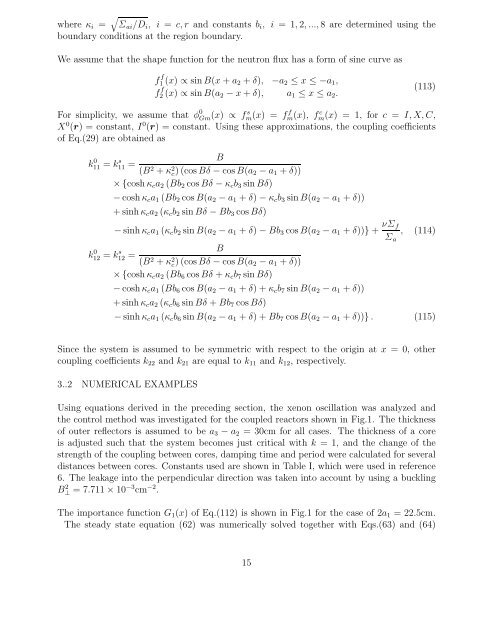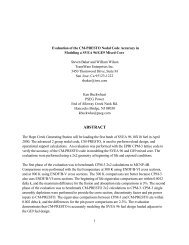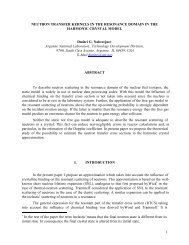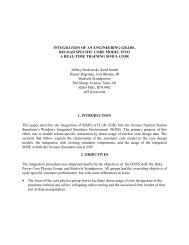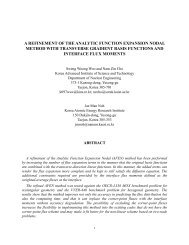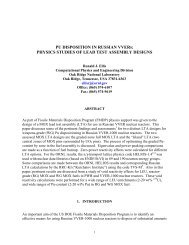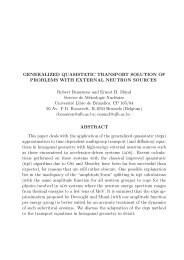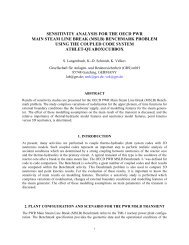K. Kobayashi and S. Tsumura
K. Kobayashi and S. Tsumura
K. Kobayashi and S. Tsumura
You also want an ePaper? Increase the reach of your titles
YUMPU automatically turns print PDFs into web optimized ePapers that Google loves.
where κi =<br />
<br />
Σai/Di, i = c, r <strong>and</strong> constants bi, i =1, 2, ..., 8 are determined using the<br />
boundary conditions at the region boundary.<br />
We assume that the shape function for the neutron flux has a form of sine curve as<br />
f f<br />
1 (x) ∝ sin B(x + a2 + δ), −a2 ≤ x ≤−a1,<br />
f f<br />
2 (x) ∝ sin B(a2 − x + δ), a1 ≤ x ≤ a2.<br />
(113)<br />
For simplicity, we assume that φ 0<br />
Gm(x) ∝ f s m(x) = f f m(x), f c m(x) = 1, for c = I,X,C,<br />
X 0 (r) = constant, I 0 (r) = constant. Using these approximations, the coupling coefficients<br />
of Eq.(29) are obtained as<br />
k 0 11 = k s B<br />
11 =<br />
(B2 + κ2 c ) (cos Bδ − cos B(a2 − a1 + δ))<br />
×{cosh κca2 (Bb2 cos Bδ − κcb3 sin Bδ)<br />
− cosh κca1 (Bb2 cos B(a2 − a1 + δ) − κcb3 sin B(a2 − a1 + δ))<br />
+ sinh κca2 (κcb2 sin Bδ − Bb3 cos Bδ)<br />
− sinh κca1 (κcb2 sin B(a2 − a1 + δ) − Bb3 cos B(a2 − a1 + δ))} + νΣf<br />
, (114)<br />
Σa<br />
k 0 12 = ks 12 =<br />
B<br />
(B2 + κ2 c ) (cos Bδ − cos B(a2 − a1 + δ))<br />
×{cosh κca2 (Bb6 cos Bδ + κcb7 sin Bδ)<br />
− cosh κca1 (Bb6 cos B(a2 − a1 + δ)+κcb7 sin B(a2 − a1 + δ))<br />
+ sinh κca2 (κcb6 sin Bδ + Bb7 cos Bδ)<br />
− sinh κca1 (κcb6 sin B(a2 − a1 + δ)+Bb7 cos B(a2 − a1 + δ))} . (115)<br />
Since the system is assumed to be symmetric with respect to the origin at x = 0, other<br />
coupling coefficients k22 <strong>and</strong> k21 are equal to k11 <strong>and</strong> k12, respectively.<br />
3..2 NUMERICAL EXAMPLES<br />
Using equations derived in the preceding section, the xenon oscillation was analyzed <strong>and</strong><br />
the control method was investigated for the coupled reactors shown in Fig.1. The thickness<br />
of outer reflectors is assumed to be a3 − a2 = 30cm for all cases. The thickness of a core<br />
is adjusted such that the system becomes just critical with k = 1, <strong>and</strong> the change of the<br />
strength of the coupling between cores, damping time <strong>and</strong> period were calculated for several<br />
distances between cores. Constants used are shown in Table I, which were used in reference<br />
6. The leakage into the perpendicular direction was taken into account by using a buckling<br />
B 2 ⊥ =7.711 × 10 −3 cm −2 .<br />
The importance function G1(x) of Eq.(112) is shown in Fig.1 for the case of 2a1 =22.5cm.<br />
The steady state equation (62) was numerically solved together with Eqs.(63) <strong>and</strong> (64)<br />
15


